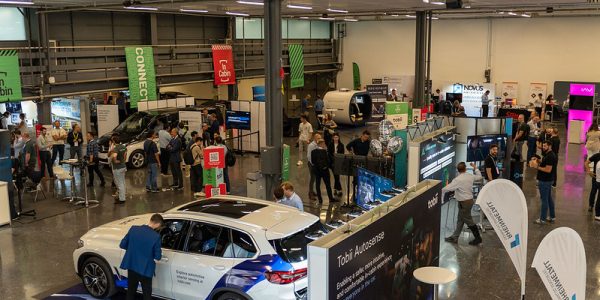
After our biggest event yet, our very own Automotive Technology Specialist, Sara Sargent, wrote a fascinating recap on her favourite moments from InCabin Europe 2024. Sara experienced firsthand the cutting-edge advancements in interior sensing, AI applications, and more. Here are Sara’s top three takeaways from this year’s event:
1. Innovations on Display
The exhibition floor at InCabin offers the most current view of technology from suppliers and Tier One companies that is being used for interior sensing and to provide comfort and convenience features. This year, I paired InCabin with the Paris Motor Show for a comprehensive supply chain experience, getting to see what actually reaches consumers.
At InCabin, there were many demonstrations focusing on intoxicated driving and vehicle technology. The intoxication demos were presented by several new companies with innovative approaches to sensing based on different medical indicators.

2. Key Industry Discussions
The conversations people have at InCabin are crucial for the industry’s next steps, whether it’s discussing something new they’ve learned or introducing someone to “a person you should meet.” I always encourage newcomers to InCabin to start with the roundtable discussions. These are excellent opportunities to engage in a conversation about a topic they’re passionate about and to meet others who can connect them with key contacts. The discussions during the busy roundtable sessions focused on the following topics:
- DMS Standards, hosted by Yash Shah of ASAM.
- The Necessity of Pre-tests for DUI Systems, hosted by Snjezana Simic of Sightic.
- Depth Sensing and InCabin Monitoring, hosted by Kristof Lieben of Melexis.
All of the discussions were well-attended and productive! I received feedback that there were some new ideas to consider and a sense of reassurance that companies are aligned on what’s important in the market.
Validation was a recurring theme in various presentations and at the exhibition stands:
- In addition to ASAM hosting a roundtable to discuss standards for interior monitoring systems, they had a booth where they could address industry questions and meet companies interested in building a closer relationship with the standards. They even brought their beloved cube around to the member companies’ booths!
- Anyverse and Google presented a shared framework for validation using simulation.
- IDIADA had a booth to connect with companies needing to perform physical Euro NCAP testing at their advanced test track.
- Adriano Palao from Euro NCAP, of course, discussed their new ratings system. Over the last year, they’ve seen a significant increase in vehicles with direct sensing in the five-star rating category. Some of the elements they are looking for include:
- Child presence detection.
- Correct seatbelt use.
- Out-of-position (OOP) airbag deactivation.
- Restraint optimization.
For DMS ratings, they’re focusing on factors like distraction, drowsiness, impairment, microsleep, unresponsiveness, and maintaining eyes on the road. The new ratings system consists of four categories, where Adriano highlighted specific inclusions:
- Safe Driving.
- Occupant Monitoring, Driving Engagement, and Vehicle Assistance.
- Crash Avoidance, including frontal and lane departure collisions.
- Crash Protection.
- Post-crash Safety.
Euro NCAP has defined timing requirements for various detections, which Adriano covered in detail in his presentation—available to watch on demand.

3. The Road Ahead
Another major theme at InCabin is the variety of ways AI is being used to improve safety and enhance the in-vehicle experience. Large language models (LLMs) for improving the in-vehicle experience were demonstrated by Smart Eye, LG Electronics, and Amazon Smart Vehicles, while predictive health was showcased by Idneo and BlueSkeye. Adriano Palao from Euro NCAP discussed how companies should implement Lane Support System adaptations based on intelligent insights. For instance, if the driver is alert and the markings on the roadway show a bike lane, but the car needs to enter the lane to allow a vehicle to pass, the system should avoid activating a lane departure warning to prevent over-alerting the driver, which could lead to disengagement.
This year, the Paris Motor Show highlighted how prevalent DMS has become in road vehicles and showcased the various convenience features now available. After AutoSens China, which takes place from November 19-21, we’re headed to CES to find the best demos and technologies to showcase at InCabin and AutoSens in Detroit in June, and Barcelona in October.
See you there!

Stay ahead of the curve in automotive innovation! Join over 10,000 engineers and specialists who receive the latest updates, insights, and discussions on ADAS and AV technology directly to their inbox. Don’t miss out! Subscribe to our newsletter today and be part of the conversation.
